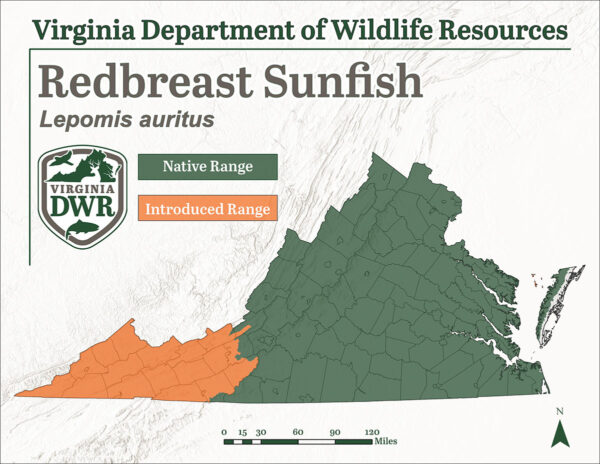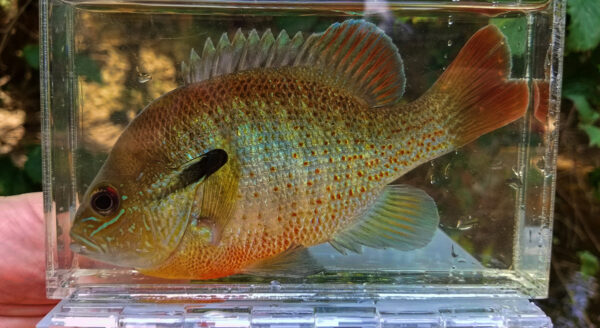An angler shows off a Redbreast Sunfish caught in a coastal plain stream.
Fisheries biologists observe a Redbreast Sunfish. ©DCR Healthy Waters Program / VCU INSTAR
Fact File
Scientific Name: Lepomis auritus
Classification: Fish, Order Perciformes, Family Centrarchidae
Size: Adult Redbreast Sunfish range from 3.5 to 8+ inches in Virginia
Life Span: Approximately 8 years
Identifying Characteristics
- A deep, heavily laterally compressed body shape
- The dorsal fin has a spinous (anterior) and soft portion
- Olive to brownish throughout the dorsal, merging with blues and golds cast along its sides, with a bright orange to yellow breast
- A long, entirely black opercular flap on the gill plate
- 3 anal spines
Habitat
Redbreast Sunfish can be found in streams and reservoirs throughout Virginia. They thrive in areas with submerged structure, or near the shoreline where there are overhanging banks. They can inhabit faster flowing waters than many other sunfish species.
Diet
Redbreast Sunfish are opportunistic feeders. They consume what is most available to them on a seasonal basis. This includes benthic macroinvertebrates, small mollusks and crustaceans, small fish, and terrestrial insects.
Distribution:
Redbreast Sunfish are native to a large portion of Virginia, with the exception of southwest Virginia where they have been introduced and maintain established populations.

Reproduction
The Redbreast Sunfish often spawns between May and July in Virginia. Males fan out a nest in coarse sand or gravel, usually near the shoreline. A female will pair with a male, and deposit eggs in the nest for the male to fertilize. While the female will leave the area once her eggs have been fertilized, male Redbreast Sunfish guard and maintain the nest, working to keep eggs free of silt until they hatch.
Last updated: August 14, 2024
The Virginia Department of Wildlife Resources Species Profile Database serves as a repository of information for Virginia’s fish and wildlife species. The database is managed and curated by the Wildlife Information and Environmental Services (WIES) program. Species profile data, distribution information, and photography is generated by the Virginia Department of Wildlife Resources, State and Federal agencies, Collection Permittees, and other trusted partners. This product is not suitable for legal, engineering, or surveying use. The Virginia Department of Wildlife Resources does not accept responsibility for any missing data, inaccuracies, or other errors which may exist. In accordance with the terms of service for this product, you agree to this disclaimer.


